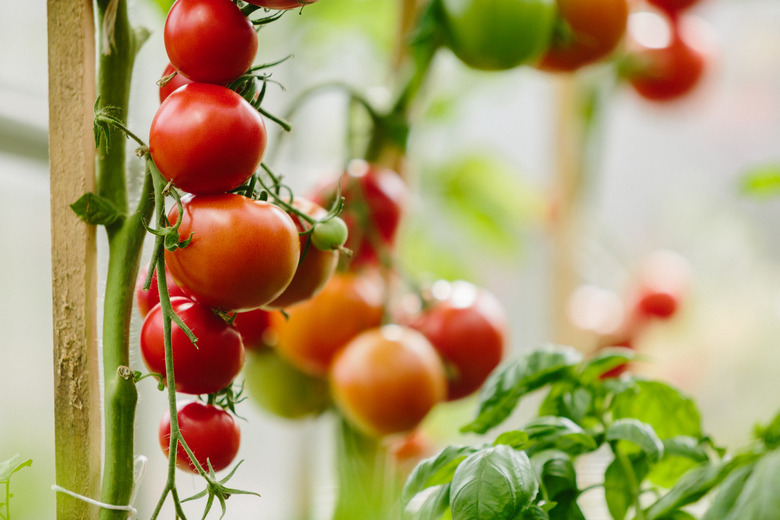Baking Soda Spray For Tomatoes
We may receive a commission on purchases made from links.
Are you curious how baking soda spray for tomatoes can help your plants? While you eagerly wait for the first bite out of one of your homegrown tomatoes (Lycopersicon esculentum, USDA zones 10-11), you might be dismayed to notice unsightly fungal growth on your plants. Before blasting the foliage with potentially harmful chemicals, try using a simple baking soda spray. The organic spray is easy to mix and could be just what you need to protect your tomato crop from nasty fungi.
Why It Works
Why It Works
Baking soda contains sodium bicarbonate, a substance that can help naturally prevent various tomato fungal diseases, including anthracnose, leaf spots, early tomato blight and powdery mildew. Baking soda spray for tomatoes doesn't actually kill the fungi, however. Instead, the sodium bicarbonate alters the pH balance of the foliage so the fungal spores can't germinate and grow, which gives baking soda fungistatic (preventive) properties instead of fungicidal (killing) action.
Baking soda on its own doesn't spread easily or adhere well to foliage. Adding horticultural oil to the spray gives it some sticking and spreading action. Oils can also help eradicate fungal spores already infecting your tomato plants.
Baking Soda Spray Recipe
Baking Soda Spray Recipe
Baking soda spray for tomatoes is easy to make, and you can mix it up right inside of your garden sprayer. Bear in mind that too much baking soda can be harmful to your plants. Leaves may turn yellow and tomato fruits may become discolored with high concentrations of baking soda.
Combine 2 1/2 tablespoons of horticultural oil with 2 gallons of water. After mixing thoroughly, add 4 teaspoons of baking soda to the solution and stir until the powder completely dissolves.
Spraying Tomato Plants
Spraying Tomato Plants
To prevent fungal diseases, apply baking soda spray for tomatoes to the plants every seven to 14 days (or after each rain event) until the humidity levels no longer promote infections. Before spraying, remove infected foliage and any garden mulch surrounding the plants. Then give your tomatoes a strong blast of water from a garden hose to help loosen up the fungal spores. Apply the baking soda solution to the buds, fruit and plant foliage, making sure you evenly coat the tops and undersides of leaves until the solution drips from the foliage.
You can use baking soda sprays up until the day before harvest, but allow the spray to dry for one to four hours before re-entering the treatment area. Avoid spraying plants in direct sunlight or when temperatures reach higher than 80 degrees Fahrenheit, or you risk burning the foliage. Spray in the early morning or evening hours when it's cooler. Reapply baking soda sprays after heavy rainfall.
Words of Caution
Words of Caution
Although nontoxic, baking soda sprays can still burn plant foliage. Test the solution on a small section of leaves, and wait at least 24 hours before inspecting for damage. If no burning occurs, spray your entire plant.
Baking soda can accumulate in the soil, which often strips the soil of magnesium and calcium while making plants less able to absorb iron. This can cause your tomato plants to experience yellowing leaves or slow growth. Avoid using baking soda sprays more often then once every 14 days when trying to prevent plant fungal infections. When working with the fungicidal spray, protect your skin and eyes by putting on safety glasses, a face mask, long sleeves and pants.
Recognizing Fungal Diseases
Recognizing Fungal Diseases
Most common tomato fungal diseases thrive when humidity levels are high and temperatures fall between 60 and 80 degrees Fahrenheit. Powdery mildew causes white to light gray spots to form on leaves. Those spots quickly spread and cover tops and undersides of leaves with a white, talcum powderlike substance. Anthracnose fruit rot causes round, water-soaked circles about 1/4 inch in diameter to form on ripening fruit.
Early tomato blight can infect fruit, leaves and stems. On leaves, it initially shows up as brown to black spots that grow into a target pattern. Infected leaves can turn yellow and fall from the plant. Fruit infections form a target pattern on immature tomatoes, while stem infections appear as gray sores with dark borders.
Septoria leaf spot affects stems and leaves, appearing as small spots with light centers and deep brown margins. The foliage surrounding the spots eventually yellows, and the entire affected leaf dies.
References
- Cornell University Vegetable MD Online: Tomato Disease Identification Key by Affected Plant Part: Stem and Whole Plant Symptoms
- Growing for Market: Home Remedies for Powdery Mildew
- Growing a Greener World: Controlling or Eliminating Powdery Mildew
- Rutgers New Jersey Agricultural Experiment Station: Diagnosing and Controlling Fungal Diseases of Tomato in the Home Garden
- Missouri Botanical Garden: Tomatoes
